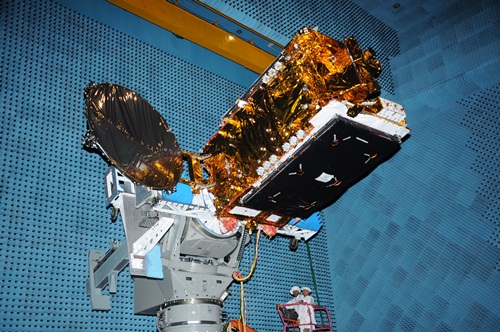India today successfully launched its latest communication satellite, GSAT-31, using the Ariane space vehicle, from the European Space Agency’s spaceport in French Guiana, during the early hours of the day.
The launch vehicle Ariane 5 VA-247 lifted off from the Ariane Launch Complex at Kourou, a French territory located in northeastern coast of South America, at 2:31 am (IST) carrying GSAT-31 and Saudi Geostationary Satellite 1/Hellas Sat 4 satellites, as scheduled.
The Ariane-5 VA-247 vehicle injected GSAT-31 into the orbit in a flawless flight lasting about 42 minutes.
After a 42-min flight, GSAT-31 separated from the Ariane 5 upper stage in an elliptical Geosynchronous Transfer Orbit with a perigee (nearest point to Earth) of 250 km and an apogee (farthest point to Earth) of 35,850 km, inclined at an angle of 3.0 degree to the equator.
With a lift-off mass of 2536 kg, GSAT-31 will augment the Ku-band transponder capacity in Geostationary Orbit. The satellite will provide continuity to operational services on some of the in-orbit satellites. GSAT-31 derives its heritage from ISRO’s earlier INSAT/GSAT satellite series.
“GSAT-31 has a unique configuration of providing flexible frequency segments and flexible coverage. The satellite will provide communication services to Indian mainland and islands” ISRO chairman K Sivan said.
Sivan also remarked that “GSAT-31 will provide DTH television services, connectivity to VSATs for ATM, stock-exchange, dgital satellite news gathering (DSNG) and e-governance applications. The satellite will also be used for bulk data transfer for a host of emerging telecommunication applications.”
After separation from Ariane-5 upper stage, the two solar arrays of GSAT-31 were automatically deployed in quick succession and ISRO's Master Control Facility at Hassan in Karnataka took over the command and control of GSAT-31 and found its health parameters normal.
In the days ahead, scientists will undertake phase-wise orbit-raising manoeuvres to place the satellite in Geostationary Orbit (36,000 km above the equator) using its on-board propulsion system.
During the final stages of its orbit raising operations, the antenna reflector of GSAT-31 will be deployed. Following this, the satellite will be put in its final orbital configuration. The satellite will be operational after the successful completion of all in-orbit tests.
“It gives me great pleasure on the successful launch of GSAT-31 spacecraft on board Ariane-5,” Indian Space Research Organisation’s (ISRO) Satish Dhawan Space Centre (SDSC) director S Pandian said at Kourou soon after the launch.
“Congratulations to Arianespace on the successful launch and precise injection of satellite into the orbit,” he added.
GSAT-31 is a “high power” communication satellite with Ku-band, and it is going to serve and replace some of the satellites that are going to expire soon, he said further.
GSAT-31 separated from the Ariane-5 in an elliptical Geosynchronous Transfer Orbit with a perigee (nearest point to Earth) of 250 km and an apogee (farthest point to Earth) of 35,850 km, inclined at an angle of 3.0 degree to the equator, ISRO said in a release after the launch.
After separation from Ariane-5, the two solar arrays of GSAT-31 were automatically deployed in quick succession and Isro’s Master Control Facility at Hassan in Karnataka took over the command and control of GSAT-31 and found its health parameters normal, it said.
Scientists will now undertake phase-wise orbit-raising manoeuvres to place the satellite in Geostationary Orbit (36,000 km above the equator) using its on-board propulsion system.
During the final stages of its orbit raising operations, the antenna reflector of GSAT-31 will be deployed, and following this, the satellite will be put in its final orbital configuration, the space agency said, adding that the satellite will be operational after the successful completion of all in-orbit tests.































